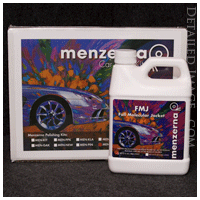Differences between Porter Cable 7424 and generic buffers
October 5th, 2007While each buffer is different I’ll point out some common differences between the Porter Cable 7424 and some of the “generic orbital buffers”. Some of these differences are subtle, but noticeable if you really want the best results. I’ll highlight some of the main differences and why they are important.
One of the best things about a Porter Cable buffer is you can attach a velcro backing plate to it. The velcro backing plate allows you to use various pads, such as the Lake Country foam pads. Changing pads takes only takes a few seconds. The Lake Country Pads are clear coat safe designed to complete each step of the detailing process with maximum results. If you want to remove swirls and imperfections you can use a more aggressive pads or if you want to apply a wax there are nice soft pads, etc. These pads are particularly important for polishing to attain maximum results.
Generic buffers typically use terry cloth bonnets that have several downsides. Some terry cloth is manufactured too firm and can potentially mar the paint. While doing the detail you most likely wouldn’t notice these micro scratches because if you are applying a wax, the wax is covering it up. However after detailing for years I’ve come to notice that some terry cloths can really harm the finish, especially as the bonnet becomes contaminated and worn down. Terry cloth is also very thin which means it can’t absorb contaminates that separate from clear coat while buffing as well as foam pads. These contaminates can grind into the clear coat, where as foam pads are better designed to absorb contaminates into its 1.25 inch thick pad. These pads are very durable so you can clean them and use them over and over again. Some generic buffers have a jerky orbital motion and far less OPMs (Orbits Per Minute), which is essential for effective polishing. The Porter Cable 7424 has a speed dial that allows you to change the power from 1 – 6 or from 2,500 to 6,000 OPM, while many competing buffers just have 1 or 2 speeds. Polishing is the step where you remove swirls, oxidation and really brighten the clear coat for maximum shine. The 3.7 amp motor is very powerful and does a great job of building consistent heat and pressure. Despite this powerful buffer it’s also very safe and has minimal risk of harming your paint. Many traditional orbital buffers require you to have two hands on it, which makes it very difficult to buff very low panels, corners, center of the roof and hood. The Porter Cable’s smooth motion and light weight (7lbs) make it very easy to maneuver around corners and near trim with one hand or two.
One of my favorite parts about the Porter Cable 7424 is its reliability because I really feel like you get what you pay for and it’s backed with a one year warranty. This is a super durable machine that you will be detailing with for years to come.






